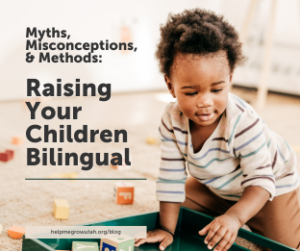 Definitions:
Definitions:
Majority Language – Most widely spoken language among a population (often one children will hear at school)
Minority Language – Less widely spoken language among a population (often spoken in the home)
I recently spoke to a friend from Mexico, who lives in the United States, and speaks Spanish to her almost 2-year-old at home. She mentioned that it’s sometimes frustrating because she knows her child understands what she’s saying, however, her child only responds in English. This is just one of the many difficulties of raising bilingual children.
Many express concerns about their children falling behind on their developmental milestones if raised with more than one language spoken at home. Some believe their children are “confused” because they mix languages as they speak. These are common misconceptions that should not deter anyone from successfully raising a bilingual child.
The truth about your child’s language progress
There are different ways to measure speech and language development if a child is learning more than one language at a time. A parent must make sure anyone evaluating their child’s communication milestones knows that the child is learning more than one language. One study found that using a language evaluation tool designed for monolingual learners, undercounted the language development of bilingual toddlers.
Children who mix languages are not confused, this is common in those who begin to learn a second language before age three, and is known as code-switching, as mentioned in the TedX video Creating Bilingual Minds and How Do Babies Become Bilingiual? Often, children know the difference between majority and minority language words and intentionally choose to use them in the same sentence.
Children begin to differentiate between languages before they are even born! If you’re interested in learning more about the process of language development in a multilingual household, check out these articles:
Development of speech perception and production in bilingual preverbal infants
‘A wonderful opportunity’: The adventure of raising bilingual children
Is it a speech delay, language delay, or bilingualism?
Strategies for teaching your child a second language
There are many approaches to enforcing a second language in your household. Here are 4 ideas you may find useful:
One Person One Language
This approach consists of attaching a language to a person. Certain people may only speak either the majority or minority language to or around the child. This could be a mother and father each speaking a different language or, if grandparents live nearby, maybe parents and grandparents each speak a different language.
Time and Place
In this context, language is attached to a time and place rather than a person. An example could be enforcing the minority language during meal times, or while you are at the park!
Minority at Home, Majority Outside
This is a common technique that can be used alongside other strategies. This method consists of speaking the minority language at home and the majority language in other locations. Some families may opt to still speak in the minority language while outside the home because children will still be exposed to the majority language outside of the home if they are interacting with other people.
Minority Language Community
This idea is mentioned in the article, ‘A wonderful opportunity’: The adventure of raising bilingual children. The idea of a minority language community gives children a support system and more opportunities to speak the minority language, even outside the home. It consists of finding friends and other supports for your child that give them more opportunities to speak. As children grow, they may be less likely to speak the minority language, but if they have friends who also speak the language, it will encourage them to continue communicating in both languages.
Learn more about these strategies from the link below:
Tips for Raising Bilingual Kids
Do what is best for your child
The article mentioned above, titled Development of speech perception and production in bilingual preverbal infants, references an article that explains how bilingual proficiency increases as both languages being taught are spoken in the home simultaneously. Parents may spend a lot of time researching language learning techniques, however, every child is different and parents should also adapt to individual needs. My friend, whom I mentioned at the beginning of this article, has focused on reading and speaking to her child in Spanish every day. As her child grows, my friend may implement new strategies, but for now this seems to be working well for them.





